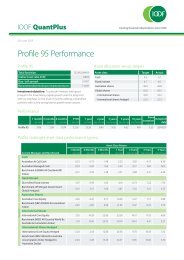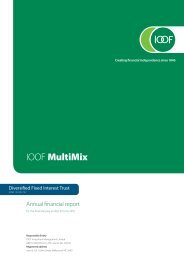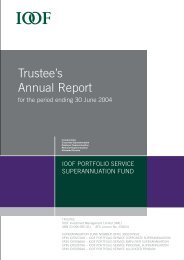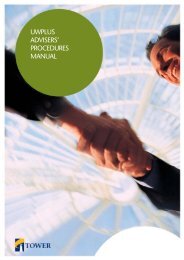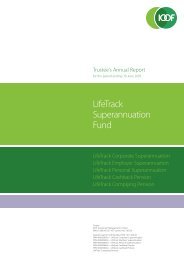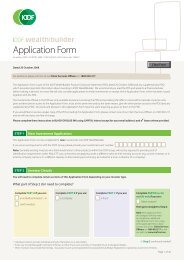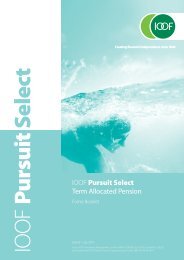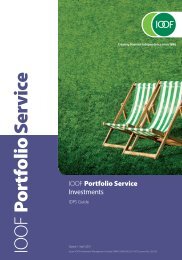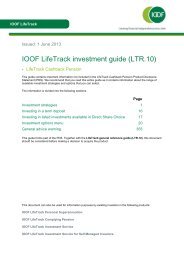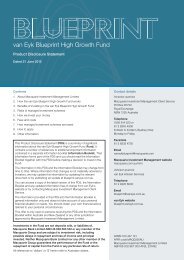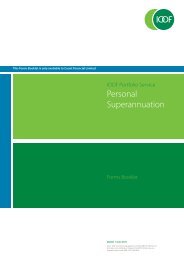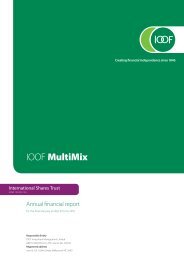annual report 2011
annual report 2011
annual report 2011
You also want an ePaper? Increase the reach of your titles
YUMPU automatically turns print PDFs into web optimized ePapers that Google loves.
IOOF | <strong>annual</strong> <strong>report</strong> <strong>2011</strong><br />
of the underlying instrument. The liability to buy back vested<br />
shares is measured and recognised in accordance with AASB<br />
139 Financial Instruments: Recognition and Measurement<br />
precluding any adjustment for the probability that settlement<br />
of the liability will occur. The directors have assessed the<br />
probability that the Group will be required to settle the<br />
share buy back liability as low and therefore recognition of<br />
movements in the reserve provides users with increased<br />
relevance and reliability of the financial performance of the<br />
Group.<br />
This change in accounting policy has had an effect on<br />
consolidated earnings per share and on net profit, further<br />
information is provided in note 4 Change in accounting policy.<br />
3 Significant accounting policies<br />
The accounting policies set out below have been applied<br />
consistently to all periods presented in these consolidated<br />
financial statements, and have been applied consistently by<br />
Group entities.<br />
Certain comparative amounts have been reclassified to<br />
conform with the current year’s presentation.<br />
(a) Basis of consolidation<br />
The consolidated financial statements incorporate the assets<br />
and liabilities of all subsidiaries of the Company as at 30 June<br />
<strong>2011</strong> and the results of all controlled subsidiaries for the year<br />
then ended. This includes the benefit funds of its subsidiary,<br />
IOOF Ltd, and any controlled trusts.<br />
Control of an entity is identified where the Group has the<br />
power to govern the financial and operating policies of that<br />
entity so as to obtain benefits from its activities, generally<br />
accompanying a shareholding of more than half of the voting<br />
rights.<br />
The benefit funds, and any trusts controlled by those funds, are<br />
treated as statutory funds in accordance with the Life Insurance<br />
Act 1995. These statutory funds, in addition to the statutory<br />
funds of the life insurance business conducted by the Group,<br />
are shown separately from shareholder funds in the notes to<br />
the financial statements.<br />
Refer to Note 3(k) Contract classification for information in<br />
relation to the different accounting treatment of investment<br />
contracts with discretionary participating features.<br />
(i)<br />
Business combinations<br />
Business combinations are accounted for using the acquisition<br />
method as at the acquisition date, which is the date on which<br />
control is transferred to the Group.<br />
Acquisitions on or after 1 July 2009<br />
For acquisitions on or after 1 July 2009, the Group measures<br />
goodwill at the acquisition date as:<br />
• the fair value of the consideration transferred; plus<br />
• the recognised amount of any non-controlling interests in<br />
the acquiree; plus if the business combination is achieved<br />
in stages, the fair value of the existing equity interest in the<br />
acquiree; less<br />
• the net recognised amount (generally fair value) of the<br />
identifiable assets acquired and liabilities assumed.<br />
When the excess is negative, a bargain purchase gain is<br />
recognised immediately in profit or loss.<br />
The consideration transferred does not include amounts<br />
related to the settlement of pre-existing relationships. Such<br />
amounts are generally recognised in profit or loss.<br />
Costs related to the acquisition, other than those associated<br />
with the issue of debt or equity securities, that the Group<br />
incurs in connection with a business combination are<br />
expensed as incurred.<br />
Any contingent consideration payable is recognised at fair<br />
value at the acquisition date. If the contingent consideration<br />
is classified as equity, it is not remeasured and settlement is<br />
accounted for within equity. Otherwise, subsequent changes<br />
to the fair value of the contingent consideration are recognised<br />
in profit or loss.<br />
When share-based payment awards (replacement awards) are<br />
required to be exchanged for awards held by the acquiree’s<br />
employees (acquiree’s awards) and relate to past services, then<br />
all or a portion of the amount of the acquiree’s replacement<br />
awards is included in measuring the consideration transferred<br />
in the business combination. This determination is based on<br />
the market-based value of the replacement awards compared<br />
with the market-based value of the acquiree’s awards and the<br />
extent to which the replacement awards relate to past and/or<br />
future service.<br />
Acquisitions between 1 July 2004 and 1 July 2009<br />
For acquisitions between 1 July 2004 and 1 July 2009, goodwill<br />
represents the excess of the cost of the acquisition over the<br />
Group’s interest in the recognised amount (generally fair value)<br />
of the identifiable assets, liabilities and contingent liabilities<br />
of the acquiree. When the excess was a negative, a bargain<br />
purchase gain was recognised immediately in profit or loss.<br />
Transaction costs, other than those associated with the<br />
issue of debt or equity securities, that the Group incurred in<br />
connection with the business combinations were capitalised<br />
as part of the cost of the acquisition.<br />
page 55



